Official Name
Český Krumlov, from now on written as 'Cesky Krumlov', since some computers do not display special characters correctly. The German name, which was in use for a long time, is Krumau (also 'Böhmisch Krumau' and 'Krummau'). Cesky means 'Bohemian'.
Location

| ||
| Český Krumlov |
Cesky Krumlov is around 145 km south of →Prague and at the northern foot of Šumava mountains (also known as the Bavarian Forest). The Austrian border is only 25 km away. Almost the entire old city centre is surrounded by the Vltava (Moldau) river, which flows north towards Prague.
Population
Cesky Krumlov has less then 15,000 inhabitants and therefore it is not much bigger than centuries ago.
Orientation
Here, the small Vltava river winds through the mountains. Most of the old centre stretches on a narrow meander spur. In the north, the long castle and the monastery tower high above the river and city centre.
The small train station is quite out of the way. From there, one just has to go down a very long slope. After 1.5 km, you will pass Budějovická brána (Budweis gate). There, the historical core starts. If you keep on walking southwards, you will come across the ČEDOK tourist information on the right side. On the left-hand side of the street, there's a big monastery. Straight ahead there is a bridge leading to the old city centre on the peninsula with the central nám Svornosti (unity square) and many narrow backstreets. If you turn right at the monastery, you will pass the Červená brána (red gate) and enter the huge Zamek (castle). The colourfully ornamented Hrádek (castle tower) is Krumlov's landmark and easy to be seen from everywhere.
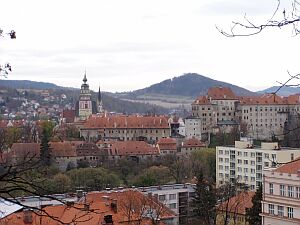
| ||
| View from the new city northwards to the castle |
The whole city is rather small and easy to navigate. Still, it takes many hours to see everything more or less closely. By the way, the bus terminal is much closer to the centre - only 300 m.
History
History of the town began in the 13th century, when the south Bohemian noble House of Vítek erected a castle. Protected by the castle, a lower city started to develop. However, at the end of the 14th century there were less than 100 houses.
The Vítek's left the stage, to be followed by the Rožemberks. At that time, the Rozemberks were the biggest landowners of Bohemia. In the 18th century, the Schwarzenberg's took over. Eversince, the Sudeten-Germans outnumbered the Czech population, which of course suddenly changed in 1945 (see also →Czech history).
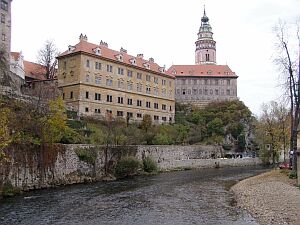
| ||
| The Vltava river, castle tower and lower castle |
The castle as well as the entire historic centre managed to survive all wars and turmoils without being damaged at all. It seems like there's not a single new building in the centre. Additionally, the settings of the town, featuring the meandering Vltava river, is marvellous. Not surprisingly, the entire historic centre had been added to the world heritage list by the UNESCO in 1992. There's not only mankind but also nature to impose destructive powers. The disastrous flooding in 2002 hit the lower parts of the city hard. Reconstruction of affected areas is highly supported and shows visible progress, so by the time you read this, it might already have been completed. However, the small Vltava remains a potential source of danger. Due to historical reasons, streets are very narrow and don't provide much space to set up protective measures.
Getting there / transportation
You can get there by bus or by train. Be aware that buses are faster and, as already mentioned above, the bus station is much closer to the city centre. Although close to the Austrian border, there's no direct train to Linz or any other Austrian destination. In almost any case you will have to go via →České Budějovice (Budweis). From there, the local train needs almost one hour, the fare is 25 Kč (again, busses are faster). There is only one direct train a day to and from →Prague.
Without exception, the entire historic centre is worth a visit. It's not a bad idea to start a tour through the city at the dominating Hrádek (lit. castle stables), better known as the castle tower. Originally gothic, the tower had been redesigned as a renaissance building. The tower can be found next to the main entrance of the castle and is covered by colourful paintings. To get there, you'll have to cross a small square in front of the entrance (there you will find the tourist information) before passing a bridge. Below the bridge, inside the moat, there's a bear pit with three or four bears enjoying the visitors. Thanks to the bear odour, the entrance is easy to find.
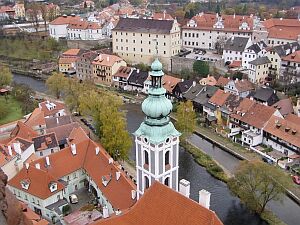
| ||
| A view from the tower: Vltava and the city centre |
As it is supposed to be, it's possible to climb the beautiful tower. Entrance fee is 30 Kč (students pay 20) and it's worth every Crown. From the top you can get a first view over the whole centre and the river loop.
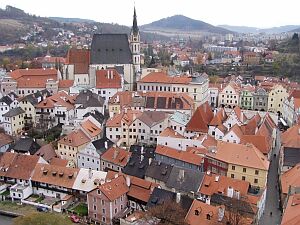
| ||
| Market square and St. Vítus church |
The zamek (castle) is definitely a highlight. Behind the tower, an area called Dolní hrad (lower castle) starts. This part was built during the 13th century and therefore it is the oldest structure in Krumlov. Inside the lower part, the visitor passes several small courtyards, all of them rich in incredibly detailed wall paintings. After passing the lower part, you will enter the monumental Horní hrad (upper castle). This part consists of massive, dark buildings almost intimedating the visitor. In contradiction to the lower part, it's possible to enter the buildings of the upper part. A guided tour in Czech, English or German through the castle will set you back 130 Kč (students pay half-price). There is plenty to see - a gallery, the castle theatre, renaissance halls and much more.
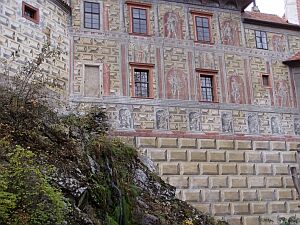
| ||
| Outer walls of the lower castle |
When you have passed both parts of the castle, you will find yourself on the top of a very high gallery called Most na pláštl (castle bridge). Under the bridge is a small path leading to a narrow bridge. Behind the bridge, Vnitřní Mésto (inner city), which is almost entirely surrounded by the river, starts.
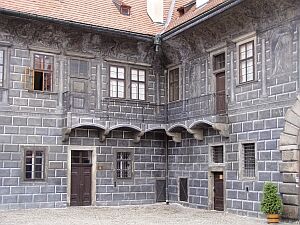
| ||
| Part of the beautiful courtyards inside the castle |
On the other side of the gallery, the castle theatre (this for a change is rococo) and the beautiful Zámecká zahrada (castle garden) can be seen. The inner city appears to be a tangle of narrow backstreets and countless souvenir shops. Cesky Krumlov has completely dedicated itself to tourism, which doesn't come as a surprise. It doesn't matter how you criss-cross the backstreets - somehow you will end up on the central nám. Svornosti (unity square).
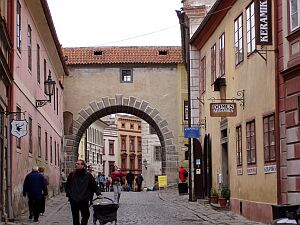
| ||
| Historical archway outside the inner city |
On unity square you will see the baroque pest column built in 1716, the gothic town hall and another tourist information, together with a nice ensemble of renaissance burgher houses. The Egon Schiele gallery facing the square is another treat for art buffs. Only 100 m away from the central square, the Kostel sv. Víta (St. Vitus church) can be seen - a large, gothic church built in the 15th century.
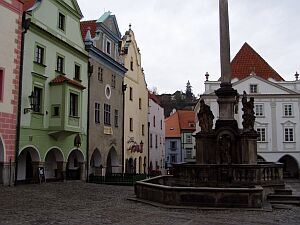
| ||
| The nám. Svornosti (unity square) and the pest column |
There's no need to worry about food - there are countless restaurants catering the hungry visitors in Cesky Krumlov. The quality is mostly good, and there shouldn't be a communication problem, since most staff speak German and English. German menus and ads can be seen everywhere, because Austria is very close. Although a tourist place, prices are still reasonable.
There is definitely no lack of accommodation of all types - most of them pensions or hotels. When you enter the old city centre from the train station, you will stumble across Hostel 99 next to Budějovická brána (Budweiser gate). A very international place and popular with backpackers, a bed in the dormitory costs 250 Kč. As in any other Czech city, the best bet is to go straight to the tourist information and ask for their competent help.
- www.ckrumlov.info Official website of Český Krumlov with plenty of infomation. Good reading to start with. Comes in English, Czech and German.
Do you have or do you know a good website about Český Krumlov? Don't hesitate, let me know! After checking it, I would love to add it to the link list. You can submit a link by using the →contact form. Note that commercial websites will be treated differently.
©2024 Europe-East.com

 Albania
Albania Czech Republic
Czech Republic